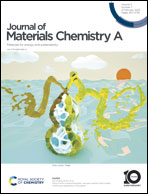Immobilizing and boosting lithium polyselenide conversion via a WSe2/WO2 heterostructure engineering strategy for lithium–selenium batteries†
Abstract
Crystalline selenium, characterized by higher electronic conductivity and volumetric capacity, represents one of the most promising cathode materials for next-generation battery technologies. However, the notorious lithium polyselenide shuttle effects yield formidable challenges, causing overcharge problems and unsatisfactory cycle performances. In this work, a nanosheet on nanorod WSe2/WO2 heterostructure was firstly developed as a proof of concept to immobilize and catalyze the soluble lithium polyselenides species. Through an in situ selenization process, the W5O14–ethylenediamine nanorod precursor was transformed to the WSe2/WO2 heterostructure, which was composed of long WO2 nanorods and WSe2 nanosheets. A combination of visual adsorption/permeation experiments, Li2Se electrochemical deposition tests, and theoretical calculations unraveled the strong chemical anchoring and efficient re-utilization toward soluble Li2Se6 and Li2Se4 species on the as-designed WSe2/WO2 heterostructure, which can originate from the bridge-shaped interfacial bonding structure. As anticipated, Li–Se batteries based on WSe2/WO2 heterostructure-modified separator exhibited dramatically improved overcharge property (overcharge capacity is 28.3 mA h g−1, only 73.7% of that with pristine PP separator) and cycle performances (about 1.58 times higher than that with pristine PP separator).



 Please wait while we load your content...
Please wait while we load your content...